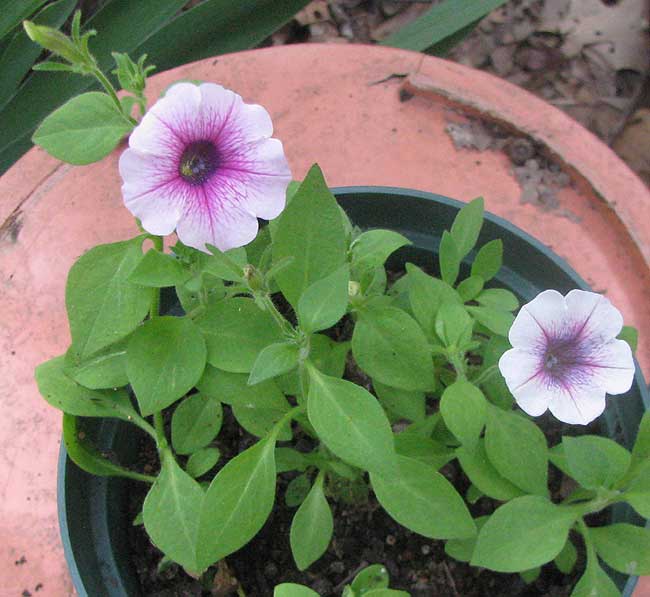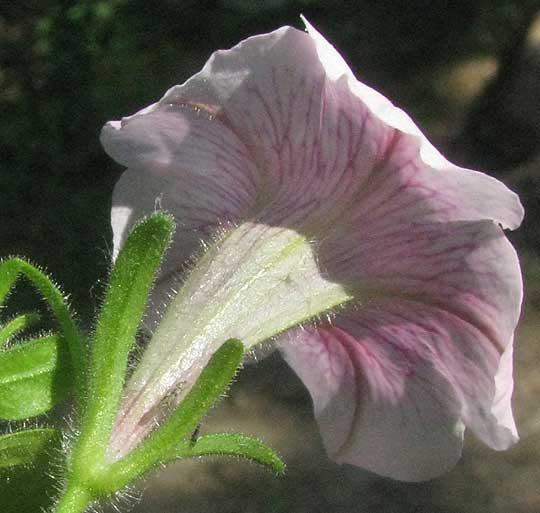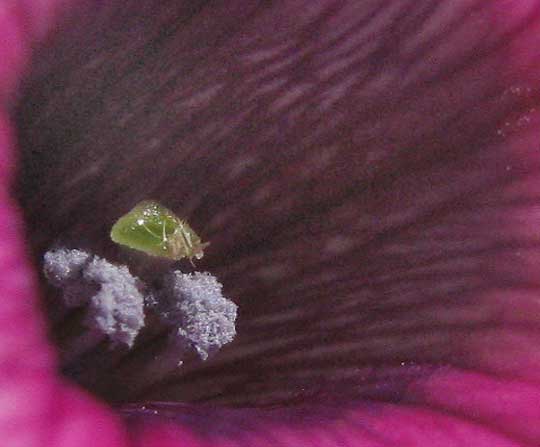Excerpts from Jim Conrad's
Naturalist Newsletter

from the the June 10, 2012 Newsletter issued from the woods of the Loess Hill Region a few miles east of Natchez, Mississippi, USA
TIDAL WAVE SILVER PETUNIAS
Next to the parking lot where Karen works flowerbeds were carpeted with two-inch-high
(5cm) herbs heavily laden with 1-1/5-inch-wide (3cm) flowers of many colors. Karen couldn't keep herself from plucking a few plants from the flowerbed edge and bringing them home. By the time they got to me the flowers were off and the leaves a bit crinkled but now, about a month later, I've coaxed the plants back to life. In fact, they're more robust now than earlier. Those are the first flowers above.
They're petunias! They hadn't been recognized from the beginning because so many petunia cultivars have been produced, mostly from hybridization, that nowadays it's hard to say what a "typical" petunia looks like. In general, petunias are much-branching, weak-stemmed and straggling herbs invested with long, sticky hairs ("viscid-pubescent"). A view of a blossom from behind shows certain other petunia field-marks below:

The corolla is funnel-shaped with five widely spreading lobes. The calyx is deeply five-cleft with narrowly oblong lobes, or sepals. Also, though petunias give the impression of exhibiting a rainbow of colors, the main ones are white and shades of pink to purple. Looking into the corolla's throat you see other distinguishing features, as seen below:

The green item with debris sticking to it is the pistil's sticky stigma, where pollen is supposed to land and germinate. Below the stigma are five pollen-producing anthers, all laden with purplish pollen. It is distinctive of the petunias that stamens are inserted on or below the middle of the corolla-tube, not below the ovary as so often is the case. Also, the five stamens are positioned with four of them paired, and the fifth much smaller or even rudimentary. The anther of this flower's smaller stamen is at the far left, clearly below the others.
The technical name for this particular cultivar -- learned by comparing a search engine's many thumbnail images -- appears to be PETUNIA X HYBRIDA 'Tidal Wave Silver.' The "x" in the binomial indicates that the taxon was produced by hybridizing two species, and "Tidal Wave Silver" is the cultivar name. I read that this cultivar is noted for its adaptability and weather tolerance, thriving even in the heat of the US Deep South.
Often the many petunia cultivars are grouped into four categories: Grandiflora; Hedgiflora (spreading); Multiflora, and; Milliflora. The cluster of "Tidal Wave" cultivars are regarded as Hedgifloras. They are used as groundcover, exactly as was the case next to the parking lot where Karen works.